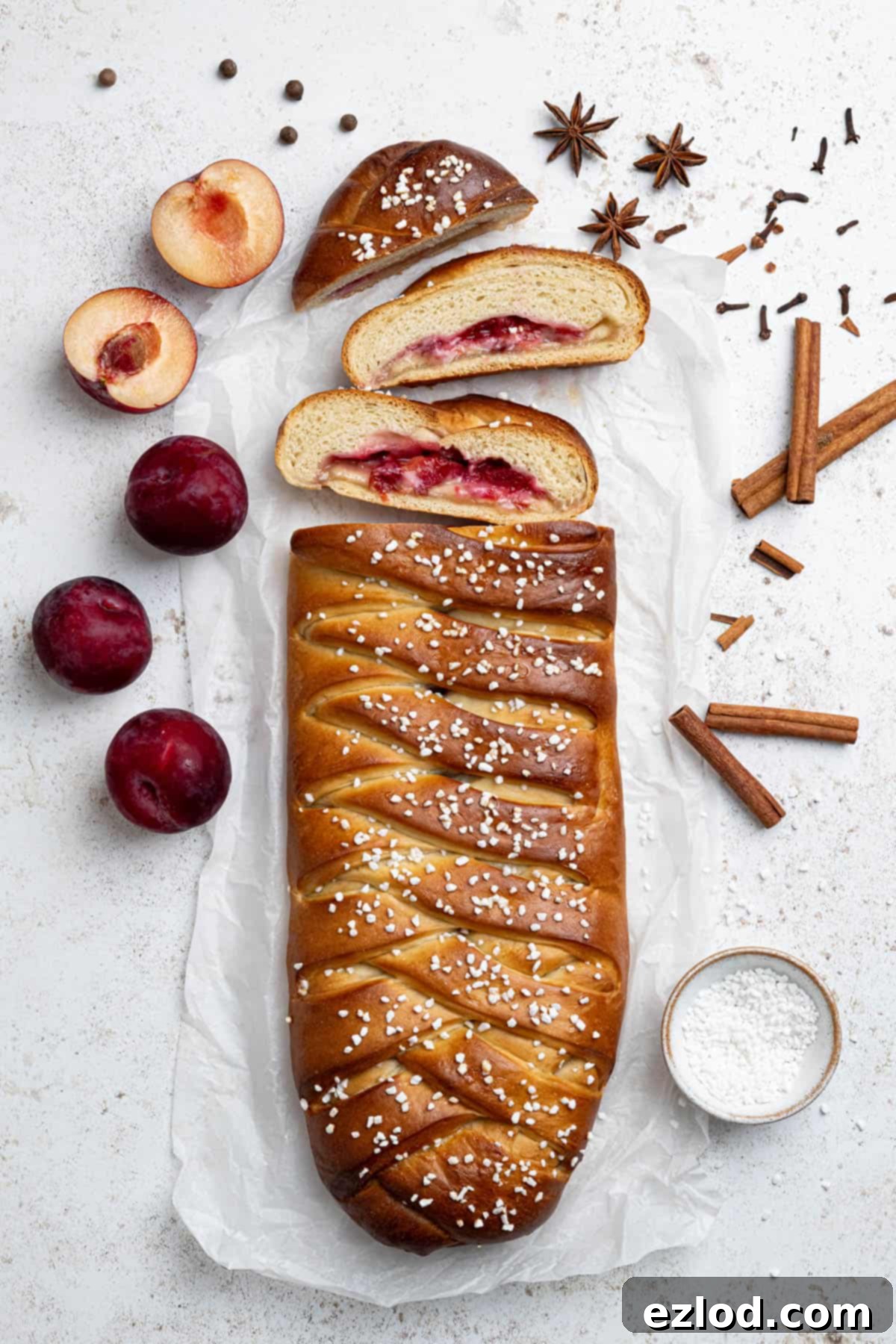Delicious Vegan Plum & Marzipan Bread: An Easy Brioche-Style Masterpiece
Indulge in the delightful aroma and exquisite taste of this vegan plum and marzipan bread, a truly remarkable creation that combines a soft, fluffy, brioche-like yeasted dough with a rich, spiced plum compote and sweet almond marzipan. This bread isn’t just a treat for the palate; it’s a feast for the eyes, crafted into an impressive braided loaf that looks sophisticated but is surprisingly simple to achieve.
Whether you’re looking for an impressive centerpiece for a fancy breakfast, a decadent addition to brunch, or a comforting snack any time of day, this plant-based bread delivers. Its comforting warmth, vibrant fruit flavors, and subtle almond sweetness make it an instant favorite, perfect for sharing with loved ones or savoring on your own.
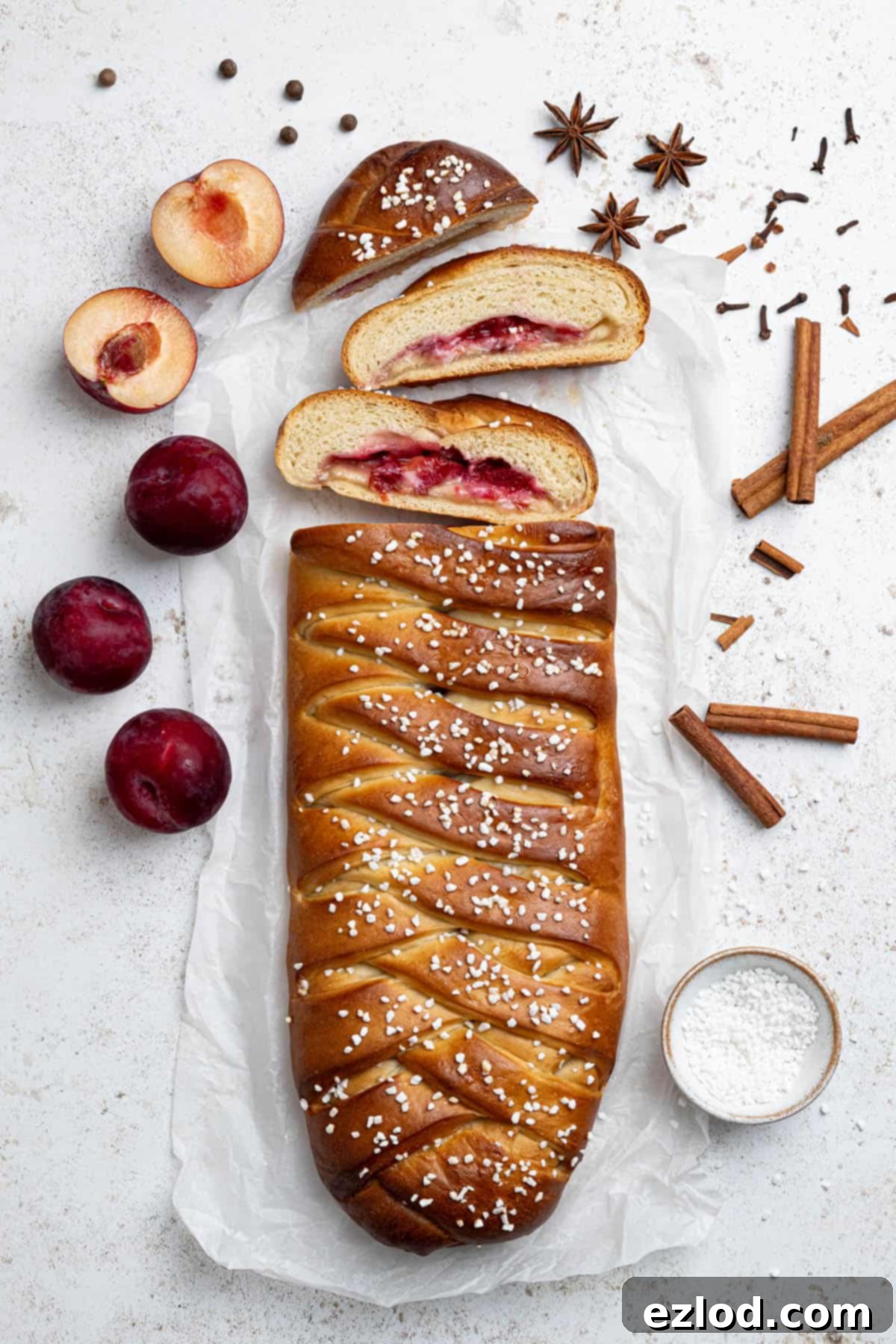
This recipe transforms simple ingredients into an incredibly moreish vegan brioche-style dough. The texture is wonderfully soft and slightly sweet, providing the perfect canvas for the juicy, warmly spiced plum compote and the aromatic almond marzipan. The shaping process, which creates a stunning braided appearance, is one of the easiest bread-making techniques you’ll master.
Forget intricate braiding skills; this method is designed for simplicity. You’ll roll out the dough into a simple rectangle, generously spread the filling down the center, then make a few strategic cuts along the sides. These wide strips are then folded alternately over the filling, creating an elaborate-looking braid in just minutes, requiring minimal coordination. It’s a fantastic way to impress without the stress!
The combination of plum and almond is a timeless classic, a flavor pairing truly made in heaven. When infused with warm spices like cinnamon and star anise, and nestled within a soft, rich, vanilla-scented dough, the result is nothing short of pure deliciousness. Each bite offers a harmonious blend of fruit, nuttiness, spice, and tender bread, making this vegan plum and marzipan bread an unforgettable culinary experience.
Why You’ll Love This Vegan Plum and Marzipan Bread
- Irresistibly Delicious: A perfect balance of sweet marzipan, tart spiced plums, and a rich, tender brioche-style dough.
- Impressively Beautiful: The braided shape makes for a stunning presentation, ideal for special occasions or a lovely weekend treat.
- Surprisingly Easy to Make: Don’t let the elegant appearance fool you; the shaping technique is incredibly straightforward, even for beginner bread bakers.
- Perfectly Plant-Based: A fantastic vegan recipe that doesn’t compromise on flavor or texture, proving that dairy-free baking can be utterly luxurious.
- Versatile Serving: Excellent for breakfast, brunch, afternoon tea, or as a dessert.
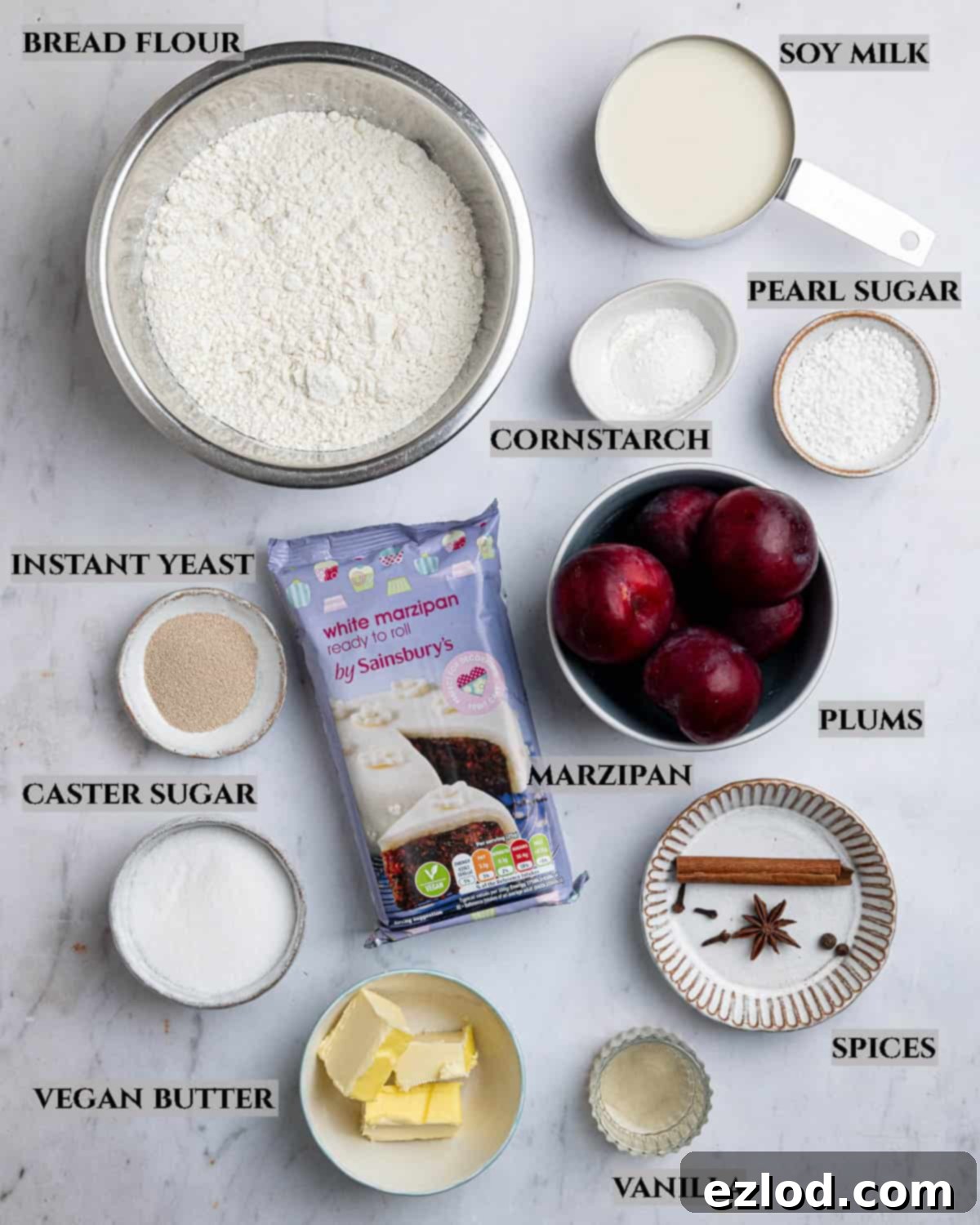
Essential Ingredient Details for Perfect Vegan Plum Marzipan Bread
Crafting this incredible vegan plum and marzipan bread starts with understanding the role of each ingredient. Here’s a detailed look at what you’ll need to create this brioche-style delight:
Bread flour: For that signature soft, fluffy, yet slightly chewy brioche-like texture, white bread flour is paramount. Its higher protein content (typically 12-14%) is essential for developing strong gluten, which gives the dough its elasticity and structure, allowing it to rise beautifully. While plain (all-purpose) flour can be used in a pinch, expect a slightly less chewy and tender result. I strongly advise against using wholemeal (whole wheat) flour, as its higher fiber content will inhibit gluten development, resulting in a much denser, heavier bread, far from the desired light and airy texture.
Instant/fast action yeast: My preferred choice for bread baking is always fast action yeast. This type of yeast is designed for convenience; it can be mixed directly with the dry ingredients without the need for prior activation in liquid, saving you time and effort. It works efficiently, ensuring a reliable and consistent rise for your dough. Always check the expiration date on your yeast packet; expired yeast is the number one culprit for bread that fails to rise.
Salt: A non-negotiable ingredient in any bread recipe, salt plays a crucial role beyond just flavor. It strengthens the gluten network, controlling the yeast’s activity and preventing the dough from over-proofing too quickly. Without salt, your bread would taste bland and likely have a poor texture. Do not omit it.
Non-dairy milk: When it comes to plant-based baking, soy milk is my top recommendation. Its higher protein content and creamy consistency most closely mimic dairy milk, contributing to a rich, tender crumb in baked goods. However, any variety of unsweetened non-dairy milk (such as almond, oat, or cashew milk) will work. Opt for unsweetened versions to better control the overall sweetness of the bread.
Sugar: Caster sugar (superfine granulated sugar) is my choice for the dough because its fine crystals dissolve quickly and evenly, ensuring a smooth dough texture. Granulated sugar can be used as a substitute if that’s what you have on hand. For an extra touch of texture and sweetness, I love to sprinkle the top of the loaf with either pearl sugar or demerara sugar before baking, creating a beautiful caramelized crust.
Vegan butter: For the best brioche-like richness and texture, a block-style vegan butter is highly recommended. Brands like Flora Plant Butter or Naturli Vegan Block are excellent choices, as they have a firmer consistency similar to dairy butter, which is crucial for dough structure. While spreadable vegan butter will work, it may result in a softer, less structured dough, affecting the final texture of the bread.
Plums: You’ll need approximately 6 medium-sized plums for the compote. The key is to select plums that are ripe but not overly soft or mushy. Ripe plums offer the best natural sweetness and juiciness, which are essential for a flavorful compote. Firmer ripe plums will hold their shape better during cooking, adding lovely visual appeal to the filling.
Marzipan: It’s critical to use marzipan, not almond paste, for this recipe. Marzipan has a firmer, more pliable texture, making it ideal for rolling and shaping within the dough. Almond paste, while similar in flavor, is softer and wetter, which could lead to a soggy filling. Most commercially available marzipan is naturally vegan-friendly, but always double-check the ingredient list on the packet to ensure it contains no animal products.
Cornflour (Cornstarch): This ingredient is vital for thickening the plum compote. Without it, the compote would be too runny, potentially saturating the dough and making your bread soggy. The cornflour, mixed with cold water to form a slurry, creates a stable, thick filling that stays neatly contained within the bread.
Spices: I prefer to use whole spices—cinnamon stick, star anise, cloves, and allspice berries—cooked directly with the compote to infuse it with deep, aromatic flavors. Using whole spices allows for a more gradual and nuanced release of flavor. If you prefer, you can substitute with powdered spices of your choosing, adjusting the quantities to taste. Warm spices are essential for complementing the sweetness of the plums and marzipan, adding depth and complexity to the overall taste.
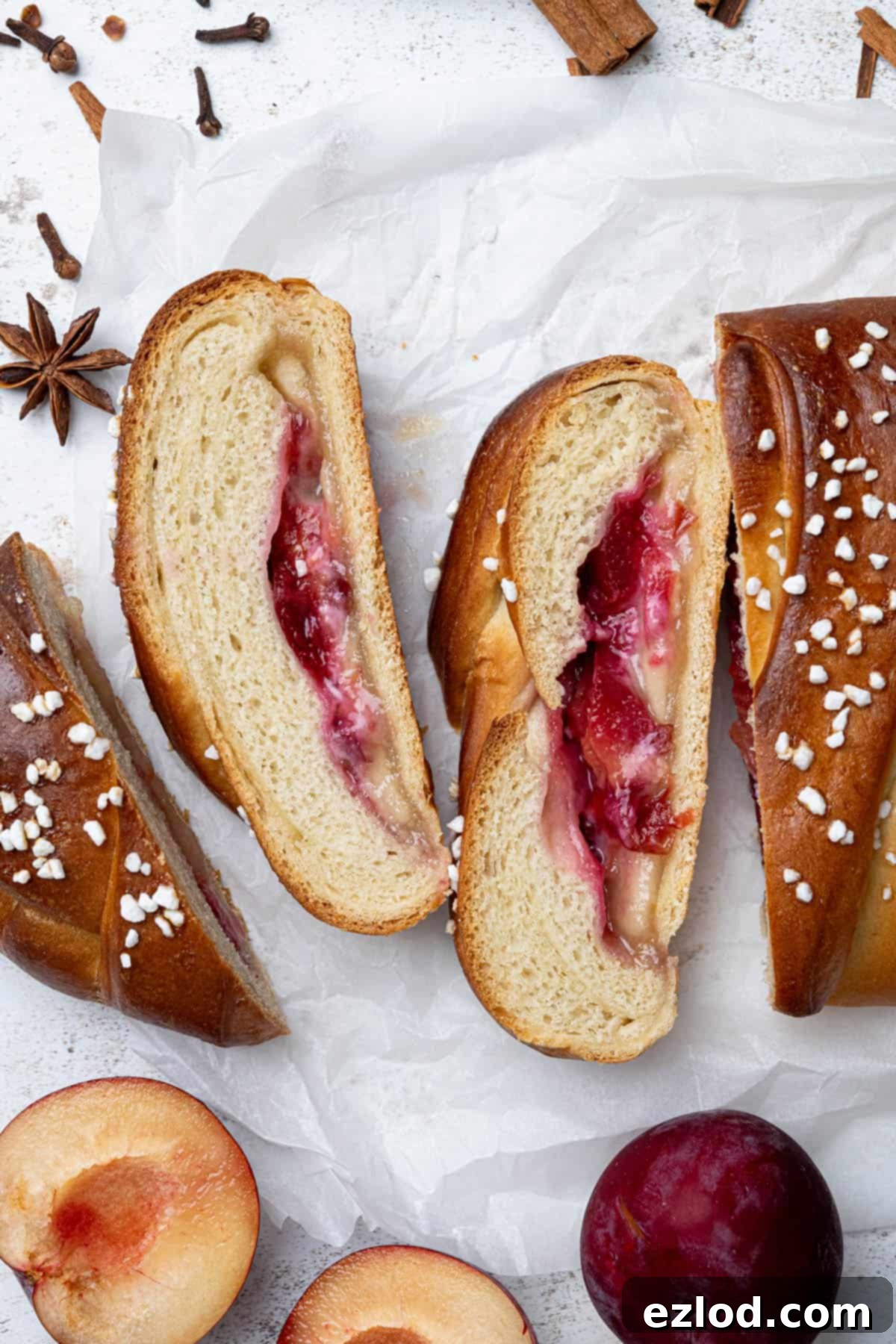
How To Make Easy Vegan Plum And Marzipan Bread: A Step-by-Step Guide
Creating this stunning vegan plum and marzipan bread is a rewarding experience. Follow these detailed steps to achieve a perfectly soft, flavorful, and beautifully braided loaf.
Step 1: Preparing the Dough Base. Begin by combining the bread flour, instant yeast, salt, and caster sugar in a large mixing bowl. Make sure to keep the yeast separated from the salt initially, as salt can inhibit yeast activity if they come into direct contact for too long. Give them a quick stir to ensure even distribution. Next, add the lukewarm non-dairy milk and vanilla extract. Mix these ingredients together using a spoon or your hands until a shaggy, somewhat crumbly dough forms. This initial stage is crucial for hydration and bringing the ingredients together.
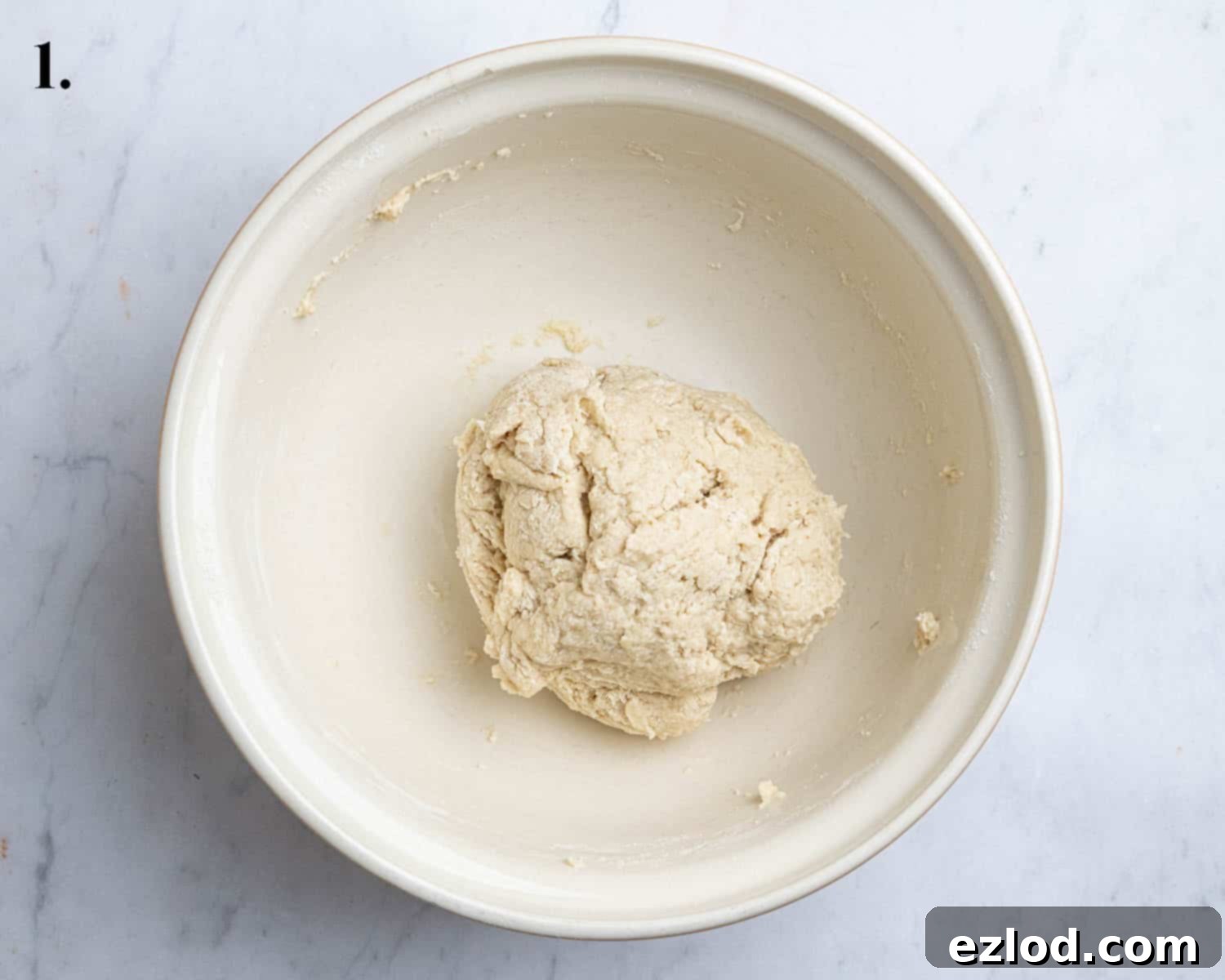
Step 2: Developing the Dough’s Elasticity. Turn the shaggy dough out onto a clean, unfloured surface. Begin kneading for 5-10 minutes. The dough will feel sticky at first, which is completely normal for a brioche-style dough. Resist the urge to add more flour unless the dough is excessively wet rather than just sticky. As you knead, the gluten will develop, and the dough will become smoother, more elastic, and less sticky, pulling away cleanly from your hands and the work surface. If you have a stand mixer with a dough hook, this process is even easier, taking about 5-7 minutes on medium speed.
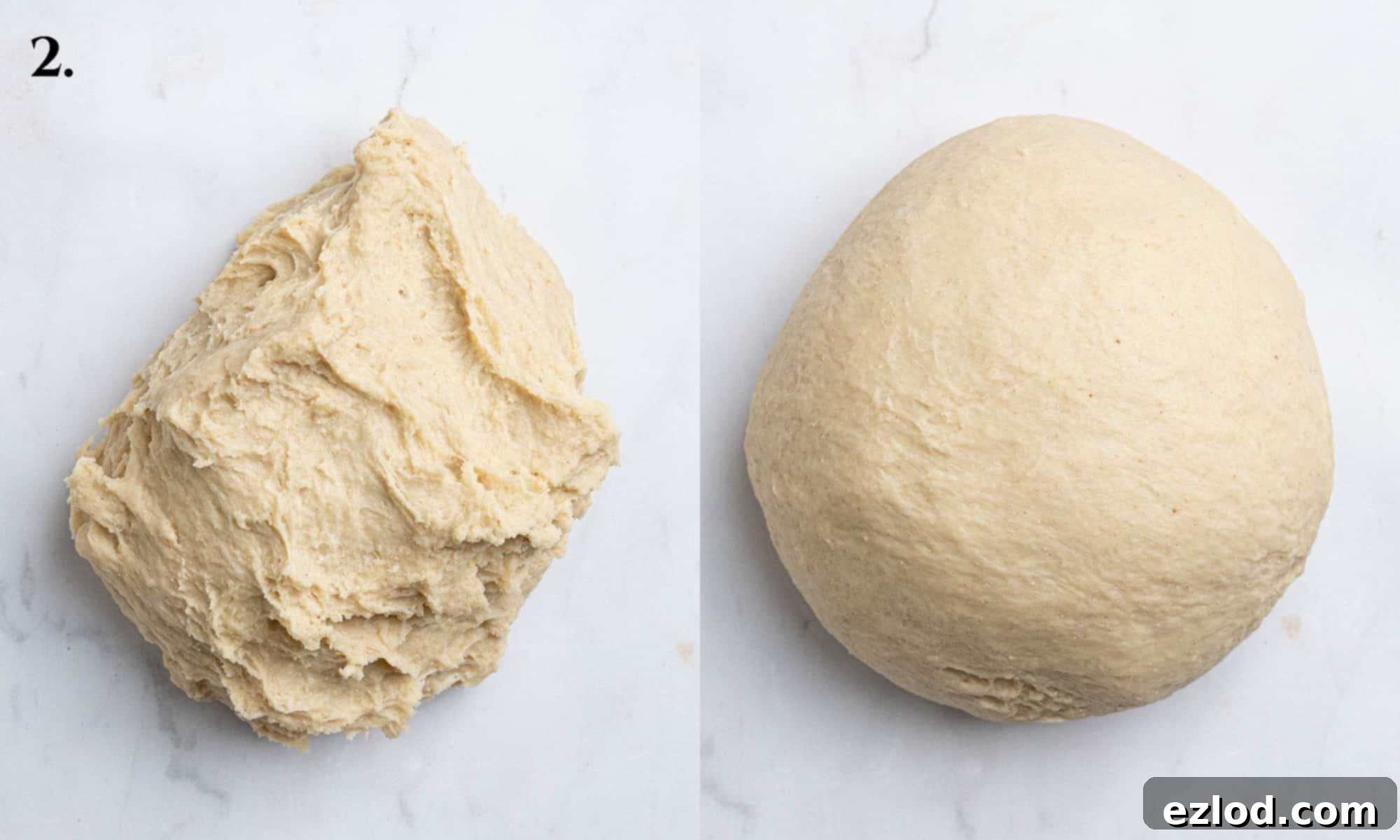
Step 3: Enriching and Rising. Once the dough is smooth and elastic, it’s time to incorporate the softened vegan block butter. Add the butter piece by piece, continuing to knead until it is fully absorbed and the dough is once again smooth, soft, and slightly tacky. This step adds richness and tenderness. Place the enriched dough into a lightly oiled bowl, turning it once to coat. Cover the bowl tightly with plastic wrap or a damp tea towel and let it rise in a warm, draft-free spot until it has doubled in size. This typically takes 1-2 hours, depending on your room temperature.
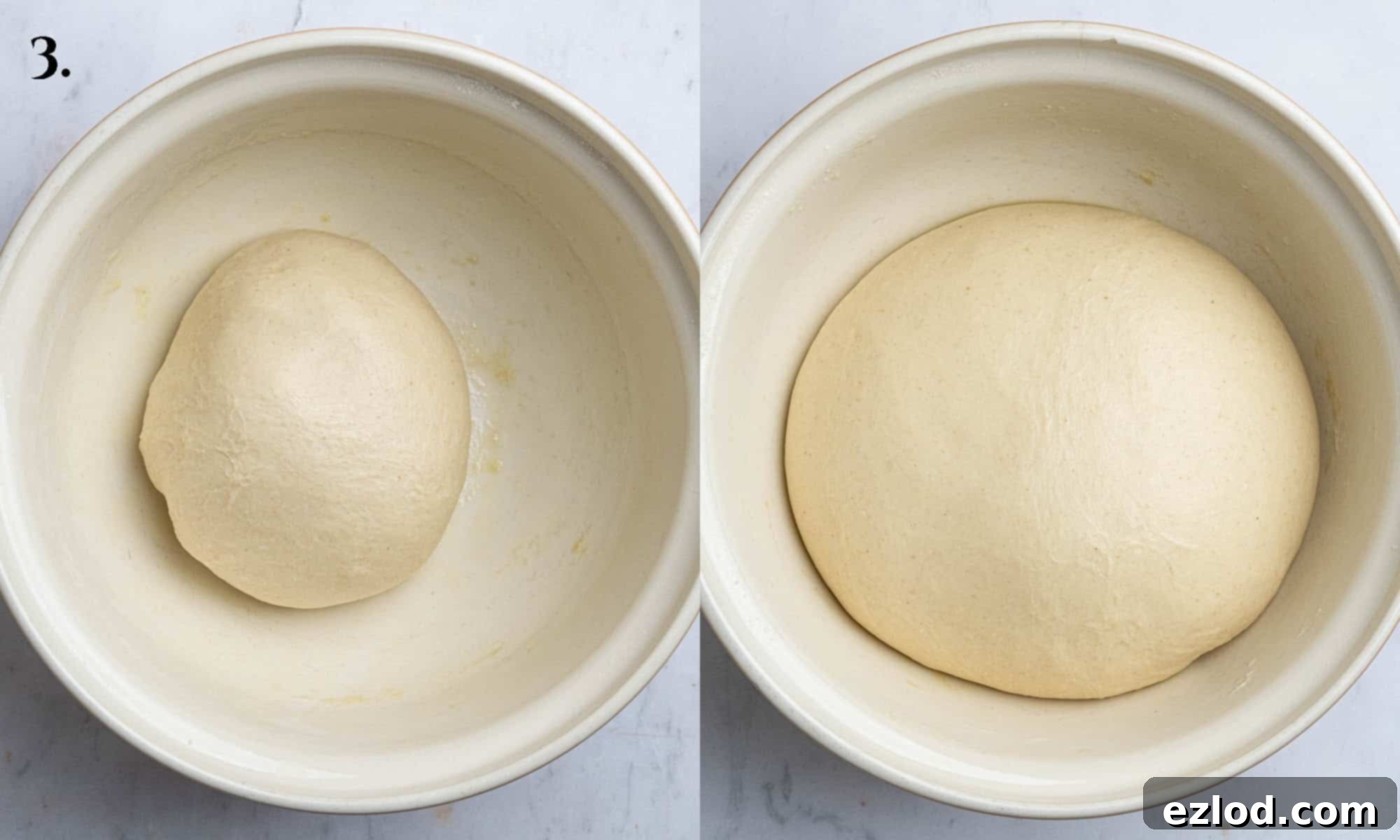
Step 4: Crafting the Spiced Plum Compote. While your dough is on its first rise, prepare the flavorful plum compote. Slice your ripe plums into quarters or eighths, removing the stones. Place them in a small saucepan with your chosen whole spices (cinnamon stick, star anise, cloves, allspice), a tablespoon of sugar, and a tablespoon of water. Bring the mixture to a gentle simmer over medium heat and cook until the plums have softened but still largely retain their shape. In a separate small bowl, mix cornflour with cold water to create a slurry. Stir this slurry into the simmering plums and continue to cook for another minute or two, stirring constantly, until the compote visibly thickens. It should be quite thick to prevent it from making the bread soggy. Remove the whole spices and set the compote aside to cool completely before using.
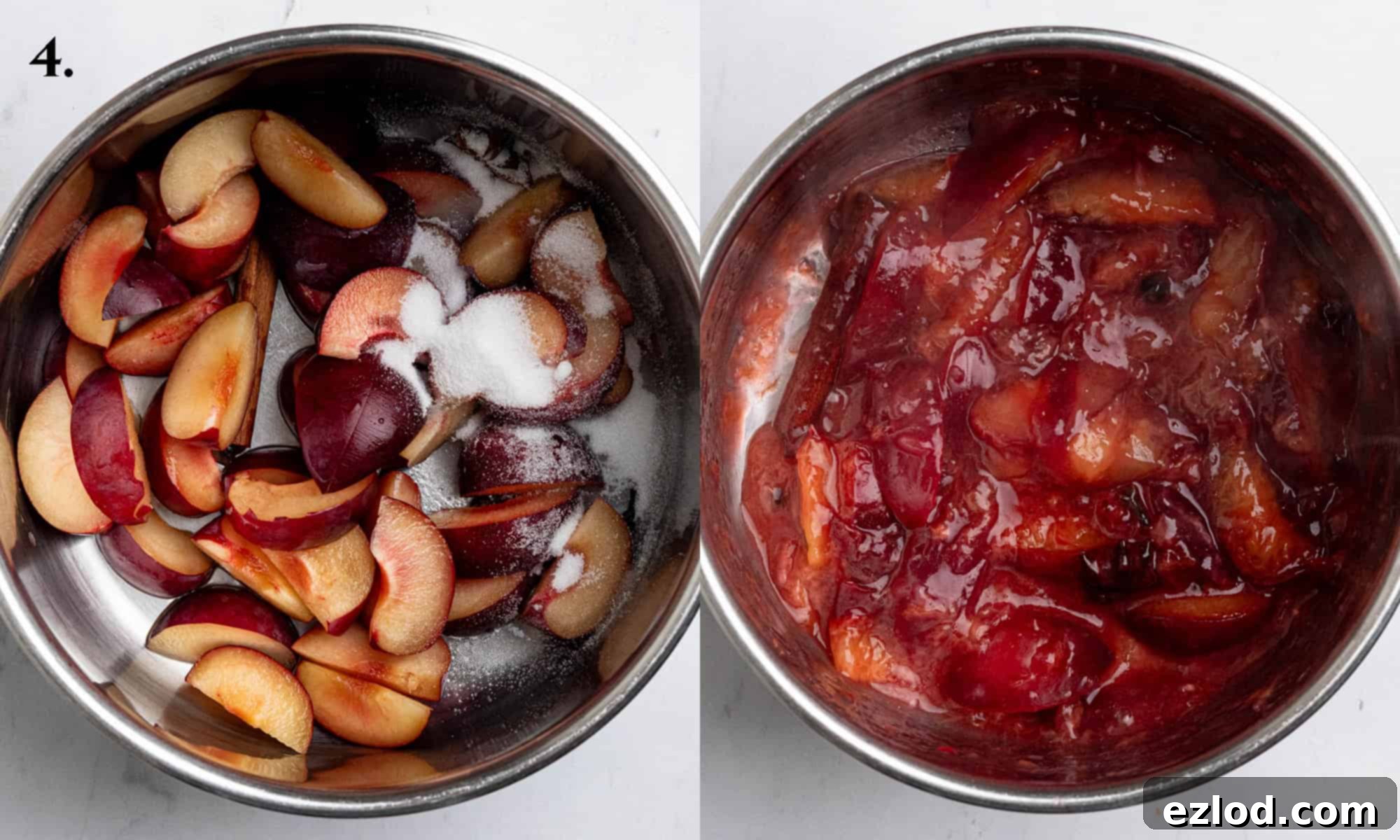
Step 5: Rolling and Preparing for Filling. Once your dough has doubled, gently punch it down to release the air. Turn it out onto a lightly floured surface and roll it into a large rectangle, approximately 25 x 38 cm (10 x 15 inches). Carefully transfer this dough rectangle onto a piece of baking parchment laid on a baking tray. Next, roll your marzipan into a long sausage shape, then flatten it into a rectangle of about 30 x 6 cm (12 x 2.5 inches). Position this marzipan rectangle down the center of your rolled-out dough, ensuring there’s about 4 cm (1.5 inches) of dough remaining at either end.
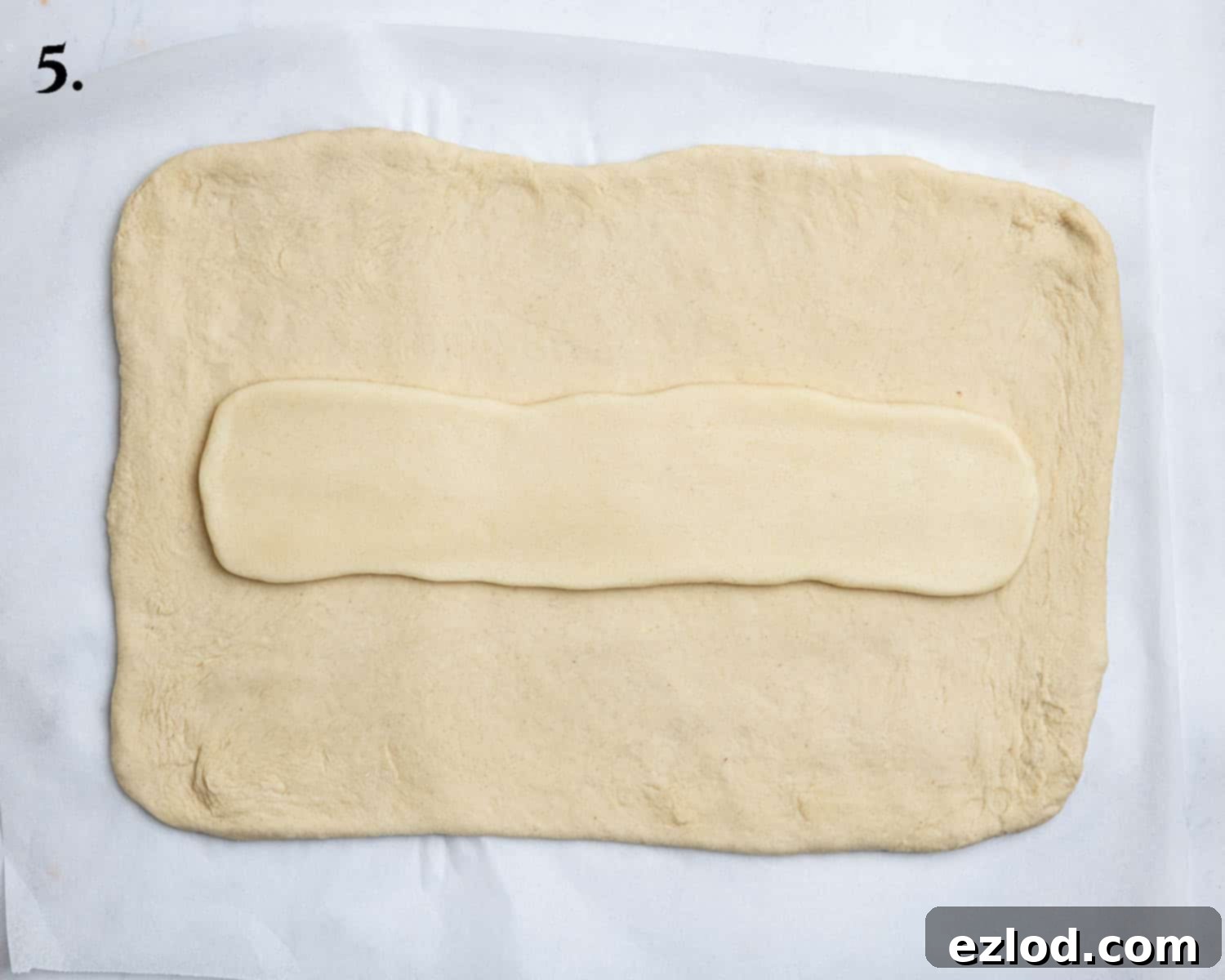
Step 6: Adding the Compote and Cutting Strips. Spoon the cooled plum compote evenly over the marzipan layer, creating a luscious filling. Now, using a sharp knife or a pizza cutter, cut diagonal strips into the dough on both sides of the filling. Each strip should be approximately 4 cm (1.5 inches) wide. Ensure you leave a border of uncut dough around the filling; do not cut through the center section containing the marzipan and compote. You should have an equal number of strips on each side.
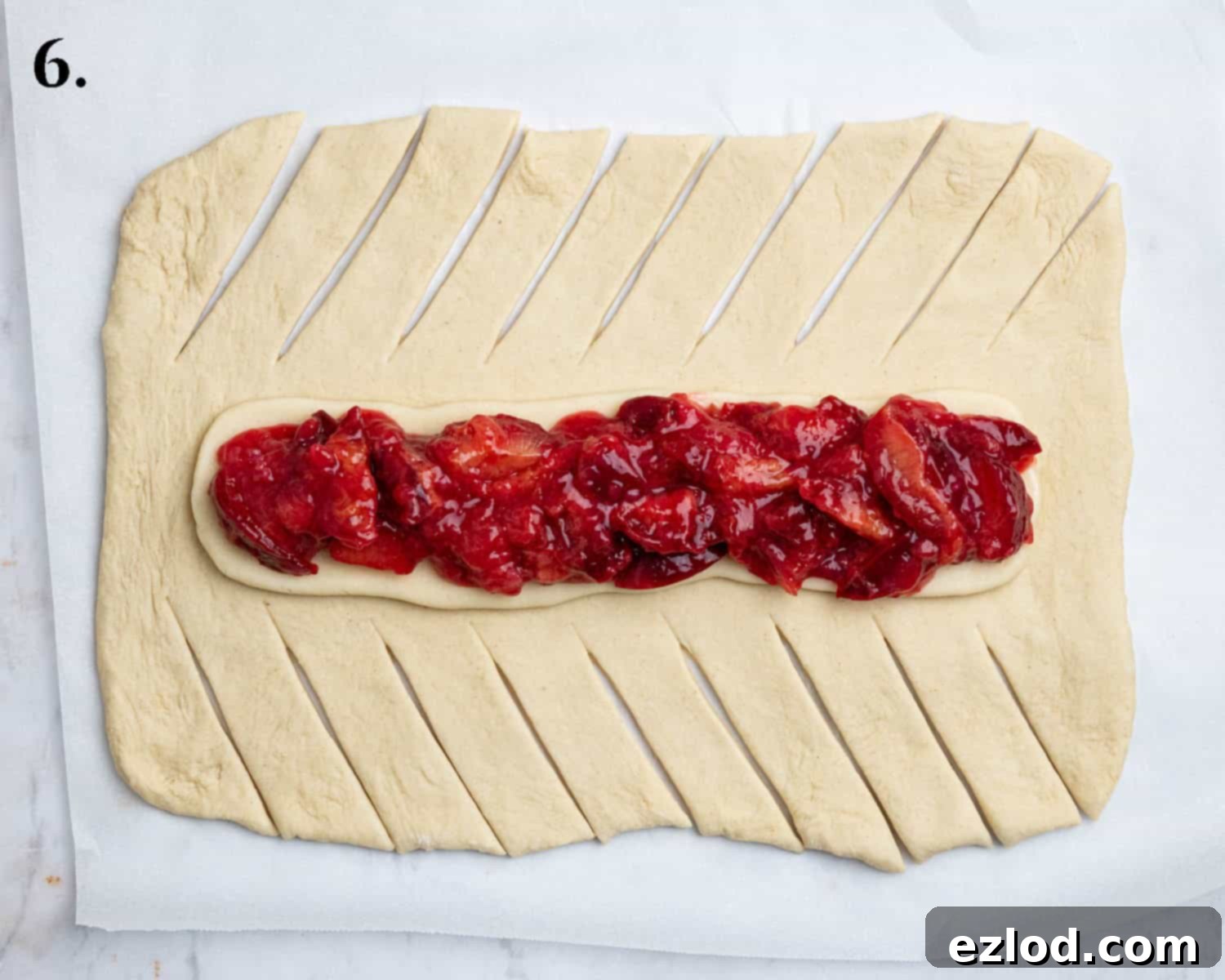
Step 7: The Easy Braid. To create the impressive braided effect, first fold up the dough at both ends over the filling. Then, begin crossing the cut strips of dough over the filling, alternating from one side to the other. Start with a strip from one side, fold it over, then take a strip from the opposite side and fold it over, slightly overlapping the previous one. Continue this process until all strips are woven, creating a beautiful, intricate-looking braid. Gently tuck in any loose ends.
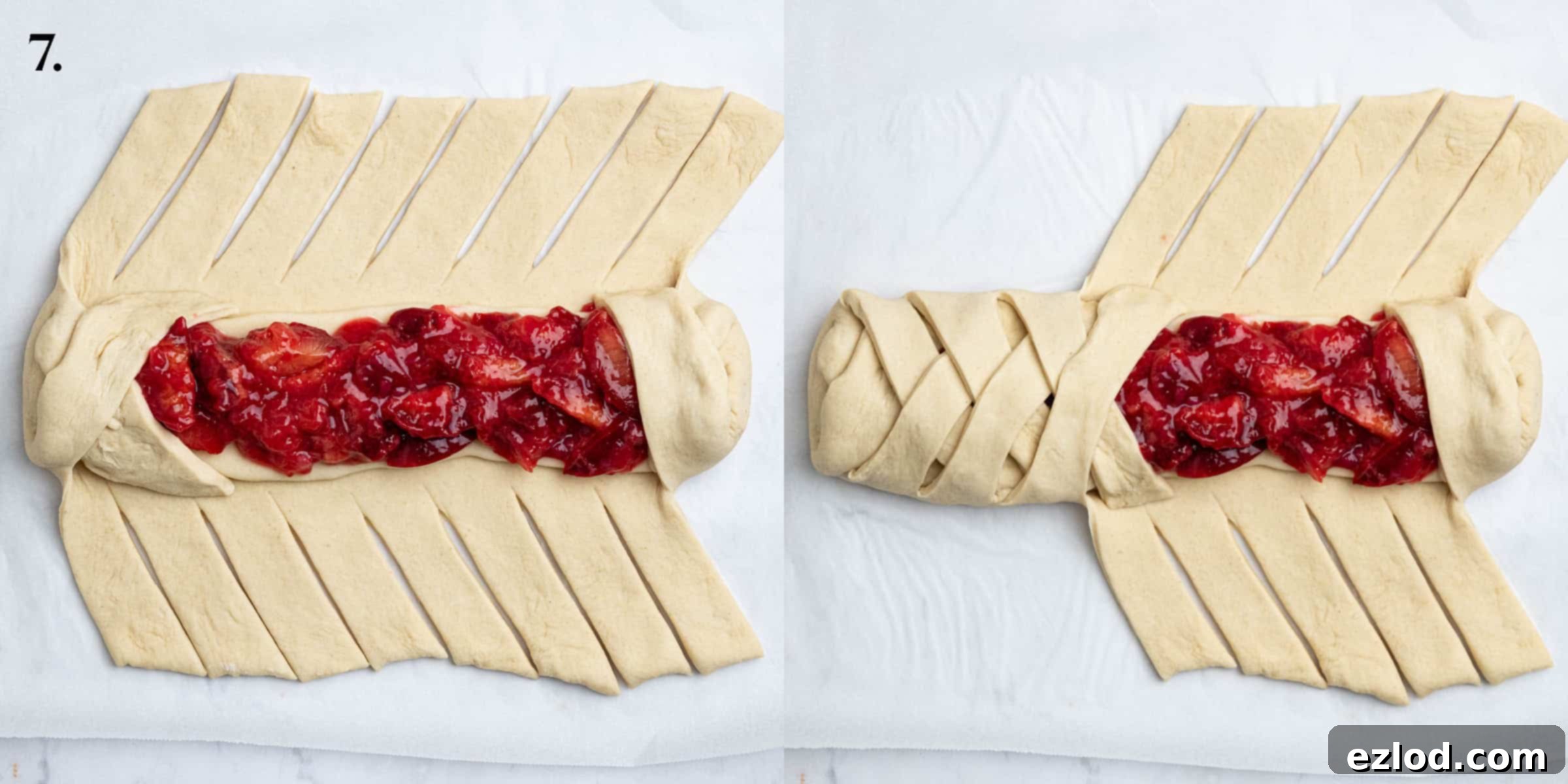
Step 8: The Second Rise (Proofing). Loosely cover your braided bread with a piece of lightly oiled plastic wrap or a clean tea towel. Set it aside in a warm spot for its second rise, or “proofing,” until it appears visibly puffy and slightly expanded. This usually takes about 45 minutes to 1 hour. You can test for readiness by gently pressing the dough with a finger; if it springs back slowly, leaving a slight indentation, it’s ready to bake. If it springs back immediately, it needs a little more time.
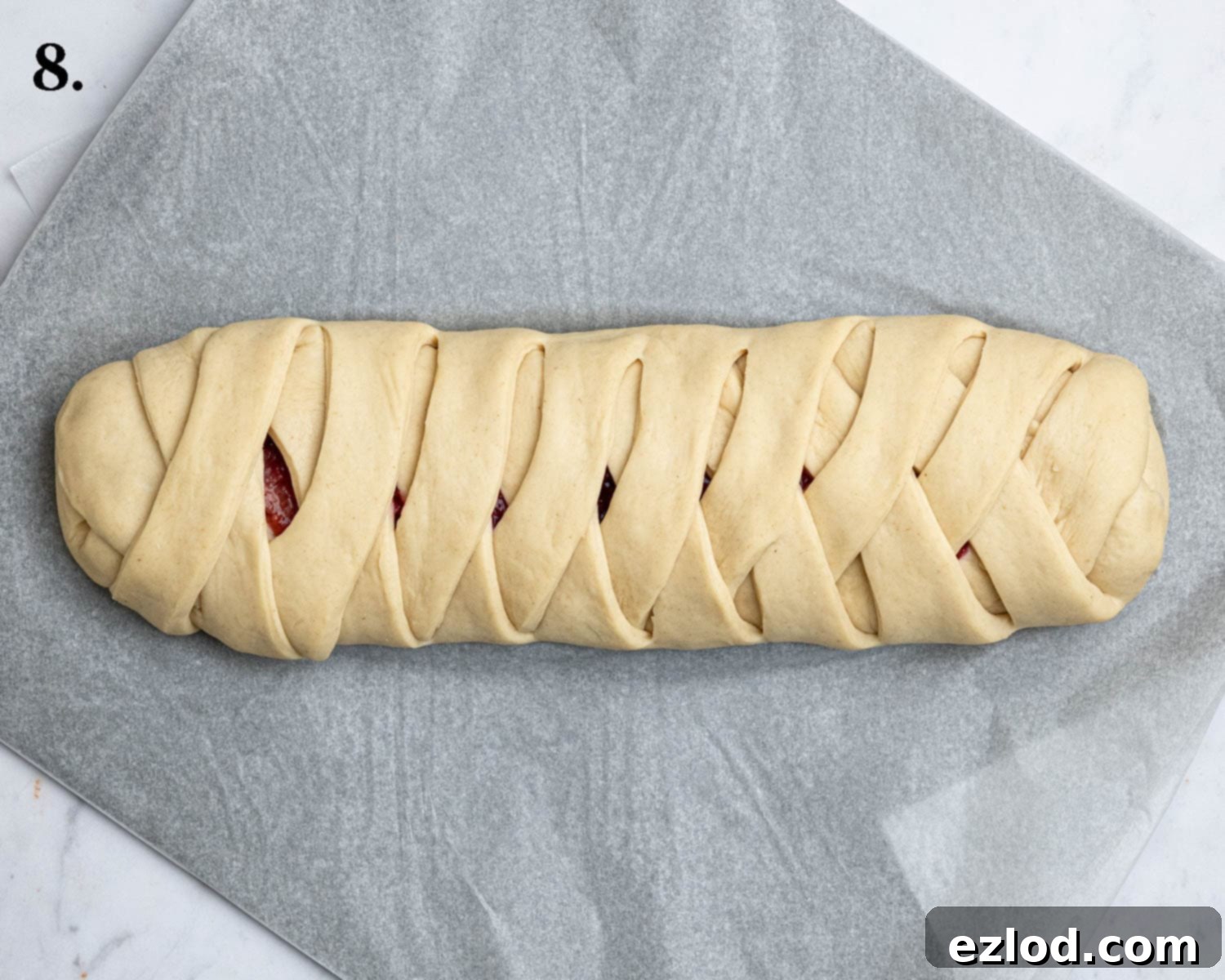
Step 9: Baking to Golden Perfection. Preheat your oven to 180°C/160°C fan/350°F/gas mark 4 during the final stages of proofing. Once the bread is proofed, gently brush the top with a little non-dairy milk (like soy milk) to encourage browning, and then sprinkle generously with demerara or pearl sugar for extra crunch and sweetness. Bake for 35-40 minutes, or until the bread is golden brown and sounds hollow when tapped on the bottom. If the top starts to brown too quickly, loosely cover it with aluminum foil to prevent over-coloring. For perfect doneness, an internal temperature of 90°C / 195°F indicates the bread is fully cooked. Allow the bread to cool on the baking tray for 10 minutes before transferring it to a wire rack to cool completely. This ensures the filling sets and the crust remains crisp.
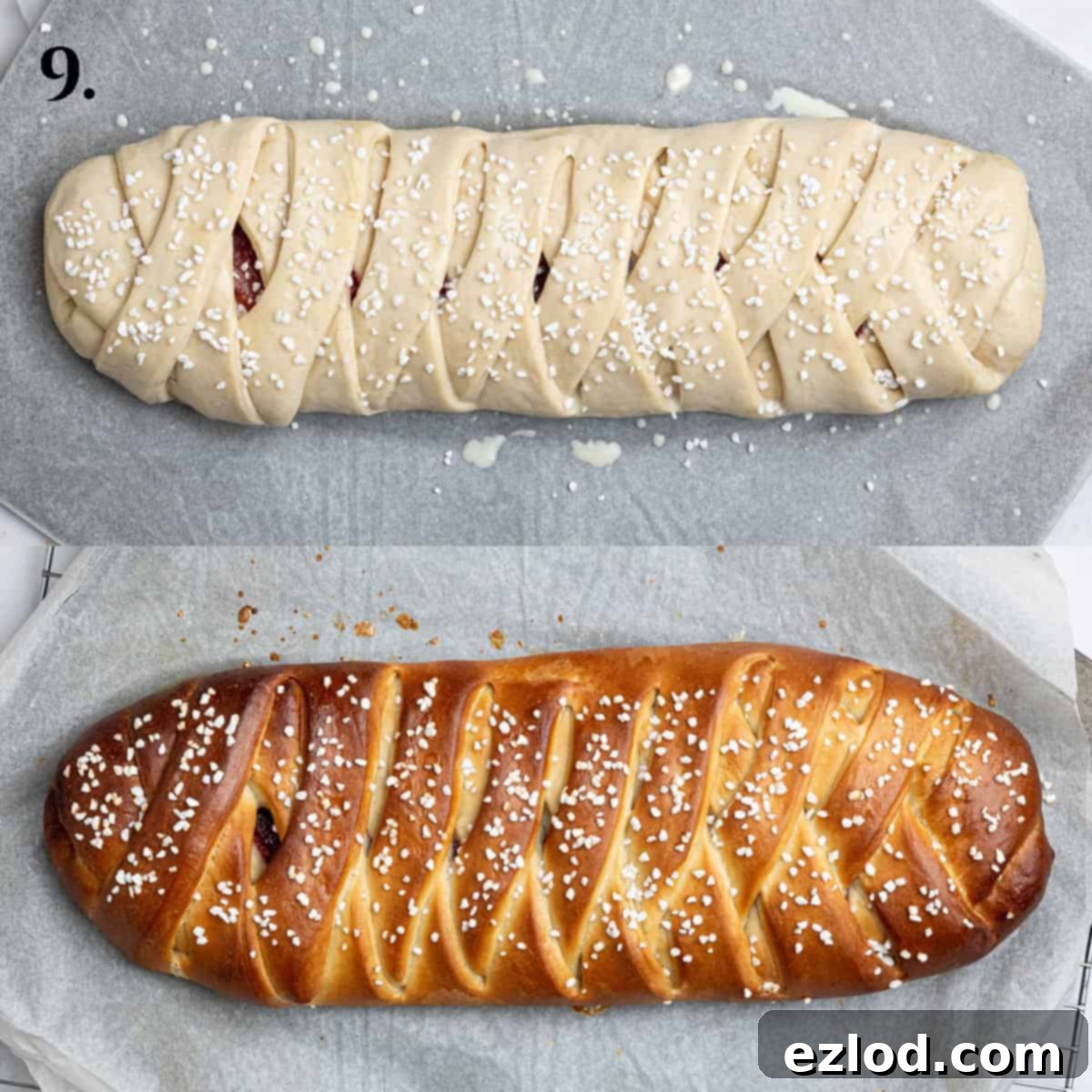

Top Tips for Baking the Best Vegan Plum & Marzipan Bread
Achieving bakery-quality vegan plum and marzipan bread is easier with a few expert tips:
- Precision is Key: Use a Digital Scale. For all baking, and especially for bread, using metric measurements with a digital scale is paramount. Cups are a notoriously inaccurate measuring system, leading to inconsistent results. A digital scale ensures precise ingredient ratios, giving you far better, more consistent outcomes. Plus, it’s often less messy!
- Check Your Yeast. Always confirm your instant or fast-action yeast is fresh and within its expiration date. Expired yeast is the most common reason for bread failing to rise, resulting in a dense, disappointing loaf. A quick test for active dry yeast (though instant is used here) is to proof it in warm water with a pinch of sugar; if it bubbles, it’s alive!
- Resist the Urge to Add More Flour. Brioche-style doughs are naturally soft and a bit sticky. Unless your dough is excessively wet and unmanageable, avoid adding more flour. Over-flouring will make the bread dry, dense, and tough, completely losing the desired light and fluffy texture. Trust the process; continue kneading, and the dough will become manageable.
- Overnight First Rise for Enhanced Flavor. For a deeper, more complex flavor profile and to break up your baking workload, consider giving the dough its first rise overnight in the refrigerator instead of at room temperature. The slow, cold fermentation develops richer notes. Remember, if you use this method, the second rise will likely take longer as the dough needs to come back to room temperature and reactivate.
- Mind the Temperature for Rising. The rising time of your dough is highly dependent on ambient temperature. In warmer conditions, the dough will rise much faster than on colder days. Adjust your rising times accordingly. If your kitchen is cool, find a warm spot (like a slightly warm oven, or near a heater) to encourage yeast activity.
- Fruit Compote Variations & Consistency. Feel free to experiment with different fruits for the compote, such as apricots, cherries, or berries. However, bear in mind that different fruits have varying water contents. You may need to adjust the amount of cornflour (cornstarch) to ensure the compote is thick and not runny. A runny filling will lead to a soggy bread interior. The compote should be firm enough to hold its shape once cooled.
- Simplify with Jam. For an even quicker preparation, you can substitute the homemade plum compote with a good quality store-bought jam. While plum jam is ideal, other flavors like cherry, raspberry, or even apricot jam would work exceptionally well and provide a delicious, easy alternative. Ensure the jam isn’t too runny.
- Ensure Perfect Doneness with a Thermometer. The most reliable way to tell if your plum and marzipan bread is fully cooked through is by using a probe thermometer. Oven temperatures can vary significantly, making precise baking times difficult to specify. Insert the thermometer into the thickest part of the loaf; the bread is done when it registers an internal temperature of 90°C / 195°F. This guarantees a perfectly baked interior without guesswork.
Frequently Asked Questions (FAQ’s) about Vegan Plum Marzipan Bread
This delicious plum and marzipan bread is undeniably at its best when enjoyed on the day it is baked. The crust is crisp, the dough is incredibly soft, and the filling is perfectly moist. However, any leftovers can be stored for up to 2 days. Keep the bread in an airtight container at cool room temperature. If your kitchen is particularly warm or during hot weather, it’s advisable to store it in the fridge to maintain freshness and prevent spoilage. Please note that as it sits, the dough will naturally absorb some of the juice from the plum compote, which might slightly alter its texture.
While you certainly can freeze leftovers, I generally wouldn’t recommend baking and freezing the entire loaf in advance of serving it for a special occasion, as the texture is best fresh. However, if you have any slices or portions remaining, they can be frozen successfully. Wrap them tightly in plastic wrap, then place them in an airtight freezer bag or container. It will keep well in the freezer for up to 3 months. To serve, simply allow the frozen bread to defrost at room temperature for a few hours. You can gently warm it in the oven for a few minutes for a “freshly baked” feel.
For the absolute best taste and texture, this bread is ideally consumed on the day it’s baked. Therefore, I don’t recommend baking the entire loaf days in advance. However, you can significantly break up the workload. The dough’s first rise can be done overnight in the fridge instead of at room temperature. Give the dough about an hour at room temperature initially to kickstart the yeast, then refrigerate it overnight. The next day, allow the dough to come back to room temperature for approximately half an hour before proceeding with shaping and the second rise. Additionally, the plum compote can be prepared a day ahead of baking. Simply store the cooled compote, covered, in the fridge until you’re ready to use it.
Unfortunately, I’m afraid this specific recipe cannot be successfully adapted using gluten-free flour. Creating gluten-free bread, especially a brioche-style one, is a complex process that requires an entirely different formulation and understanding of gluten-free flours and binders. Gluten-free baking is not my area of expertise, so I cannot provide advice on adapting this recipe. For delicious gluten-free bread, it is always best to seek out and use a recipe specifically designed to be gluten-free, rather than attempting to modify a traditional recipe that relies on gluten for its structure and texture.
Explore More Sweet Vegan Bread Recipes:
- Lemon Coconut Pull-Apart Bread
- Jamaican Spice Bun
- Vegan Banana Monkey Bread
- Vegan Pumpkin Pecan Babka
- Almond Bread Twist
- Vegan Stollen Wreath
- Vegan Chocolate Babka
- Maple Pecan Bread Wreath

We hope you love this delicious vegan plum and marzipan bread as much as we do! If you tried this recipe, please let me know how it went! Rate it, leave a comment below, or tag @domestic_gothess on Instagram and use the hashtag #domesticgothess. Your feedback is greatly appreciated!
All images and content on Domestic Gothess are copyright protected. If you want to share this recipe, please do so by using the share buttons provided. Do not screenshot or post the recipe or content in full. Instead, include a direct link to this post for the complete recipe. Thank you for respecting my work!

Print
Plum and Marzipan Bread (Vegan)
Ingredients
Dough:
- 300 g (2 ½ cups) white bread flour
- 7 g (2 ¼ teaspoons) fast action/instant yeast
- 50 g (¼ cup) caster or granulated sugar
- ½ teaspoon salt
- 190 g (¾ cup + 2 teaspoons) unsweetened non-dairy milk (I use soy) lukewarm
- 1 teaspoon vanilla extract
- 50 g (3 ½ Tablespoons) vegan block butter softened
Filling:
- about 300 g ripe plums (6 medium)
- 1 cinnamon stick
- 1 star anise
- 3 cloves
- 2 allspice berries
- 1 Tablespoon sugar
- 1 Tablespoon water
- 2 teaspoons cornflour (cornstarch) mixed with 2 teaspoons cold water
- 200 g (7 oz) marzipan
- demarera or pearl sugar for sprinkling
Instructions
-
To make the dough, place the bread flour in a large bowl, add the yeast to one side and the salt and sugar to the other, stir to combine.
-
Add the lukewarm milk and the vanilla and mix to form a shaggy dough. Turn out onto an un-floured surface and knead for 5-10 minutes until smooth and elastic. The dough will be sticky at first but resist the temptation to add extra flour, it will become smooth after a minute or two of kneading (you may need to scrape it off the surface with a dough scraper). Of course you can knead it in a stand mixer if you have one.
-
Add the softened vegan butter. Continue to knead until the butter is fully incorporated and the dough is smooth and elastic. It may seem greasy and messy at first but keep kneading and I promise you the butter will all mix in and the dough will become smooth.
-
Once the butter is fully incorporated the dough should look smooth and silky and it should pull away from the work surface or sides of the bowl cleanly. It should still be soft and slightly sticky however.
-
Place the dough in a lightly oiled bowl, cover and set aside to rise in a warm spot until doubled in size, about 1-2 hours.
-
While the dough is rising make the compote. Slice the plums into quarters if they are small, or eighths if they are large, remove the stones and place the sliced plums in a small pan with the spices, a Tablespoon of sugar and a Tablespoon of water. Bring up to a simmer and cook until the plums have softened but still retain most of their shape.
-
Add the cornstarch slurry to the plum mixture and cook for another minute or so until thickened. Depending on how juicy your plums are you may need to add a drop more water or another teaspoon of cornstarch (mixed with a teaspoon of cold water). You want the compote to be quite thick so that it doesn’t make the bread wet. Taste and add a little more sugar if required; remember that the marzipan is very sweet however so you want the compote to be on the sharp side. Set the compote aside to cool.
-
Punch down the risen dough and give it a brief knead to knock out any air bubbles. Roll the dough out on a lightly floured surface into an approximately 25 x 38 cm/ 10 x 15 inch rectangle. Transfer the rectangle onto a piece of baking parchment and place on a baking tray.
-
Roll the marzipan out into a sausage then flatten it, it should measure about 30 x 6 cm/ 12 x 2.5 inches. Place the marzipan along the centre of the rectangle of dough, there should be about an extra 4 cm/1.5 inches of dough at either end.
-
Remove the spices from the cooled plum compote and spread it on top of the marzipan.
-
Cut the dough surrounding the filling into diagonal strips about 4 cm/ 1 ½ inches wide, making sure to leave a border of uncut dough around the filling, there should be the same number of strips on either side.
-
Fold both ends up, then cross the cut strips of dough over the filling, alternating sides so that it looks like its been braided.
-
Loosely cover the dough with oiled cling film and leave it to rise until it is puffy and springs back slowly when you press it gently with a finger – about 45 minutes to 1 hour. The bread is ready to bake when it looks puffy and if you gently press the dough with a finger it springs back slowly most of the way but leaves a small indentation. If it springs back quickly and fills in completely then it isn’t ready yet.
-
While the dough is rising preheat the oven to 180°C/160℃ fan/350°F/gas mark 4.
-
Gently brush the risen dough with soya milk and sprinkle with demarera or pearl sugar. Bake for 35-40 minutes until golden and cooked through. Loosely cover with tin foil towards the end of baking if it starts to colour too much.
-
Leave the bread to cool on the tray for 10 minutes then carefully slide it onto a wire rack and leave to cool completely. Best eaten the day it is made but will keep for a couple of days in an airtight container.
Notes
- See post above for additional tips, detailed explanations, and step-by-step photos to guide you through the process.
- As with all of my baking recipes, I highly recommend using metric measurements with a digital scale rather than cup conversions. Cups are a wildly inaccurate measuring system, and using a scale will provide far better, more consistent results, not to mention it’s often easier and less messy!

